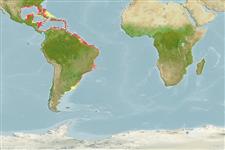Environment: milieu / climate zone / depth range / distribution range
Ecología
marino; salobre demersal; rango de profundidad 1 - 20 m (Ref. 36453). Tropical; 30°N - 44°S, 98°W - 26°W
Western Atlantic: Florida, USA and northern Gulf of Mexico to northern Argentina.
Length at first maturity / Tamaño / Peso / Age
Maturity: Lm 11.1 range ? - ? cm
Max length : 33.1 cm TL macho / no sexado; (Ref. 80009); common length : 17.0 cm TL macho / no sexado; (Ref. 5217); peso máximo publicado: 29.50 g (Ref. 118626)
Espinas dorsales (total): 0; Radios blandos dorsales (total): 52-58; Espinas anales 0; Radios blandos anales: 39 - 44
Adults occur mainly in brackish or hyper-saline lagoons (Ref. 5217), on sandy-muddy bottoms of estuaries and in the littoral zone where it hides itself leaving just its eyes out. Can easily disguise itself in the environment. Feed on worms, crustaceans and small fishes. Juveniles have a brief planktonic life, moving quickly to the benthic stage. Growth rate is relatively slow (Ref. 35237).
Life cycle and mating behavior
Madurez | Reproducción | Puesta | Huevos | Fecundidad | Larva
Robins, C.R. and G.C. Ray, 1986. A field guide to Atlantic coast fishes of North America. Houghton Mifflin Company, Boston, U.S.A. 354 p. (Ref. 7251)
IUCN Red List Status (Ref. 130435)
Threat to humans
Harmless
Human uses
Acuario: Comercial
Más información
ReferenciasAcuiculturaPerfil de acuiculturaRazasGenéticaElectrophoresesheritabilidadEnfermedadesProcesamientoNutrientsMass conversion
Herramientas
Special reports
Download XML
Fuentes de Internet
Estimates based on models
Preferred temperature (Ref.
123201): 22.5 - 28.1, mean 27.2 °C (based on 937 cells).
Phylogenetic diversity index (Ref.
82804): PD
50 = 0.5020 [Uniqueness, from 0.5 = low to 2.0 = high].
Bayesian length-weight: a=0.01230 (0.01024 - 0.01478), b=3.14 (3.09 - 3.19), in cm total length, based on LWR estimates for this species (Ref.
93245).
Nivel trófico (Ref.
69278): 3.5 ±0.4 se; based on diet studies.
Resiliencia (Ref.
120179): Medio, población duplicada en un tiempo mínimo de 1.4-4.4 años (Preliminary K or Fecundity.).
Fishing Vulnerability (Ref.
59153): Low vulnerability (23 of 100).
Nutrients (Ref.
124155): Calcium = 53.8 [21.4, 115.3] mg/100g; Iron = 0.512 [0.236, 0.922] mg/100g; Protein = 18.5 [17.1, 20.0] %; Omega3 = 0.0771 [, ] g/100g; Selenium = 25.4 [13.0, 52.9] μg/100g; VitaminA = 59.2 [15.1, 241.9] μg/100g; Zinc = 1.22 [0.79, 1.79] mg/100g (wet weight);
